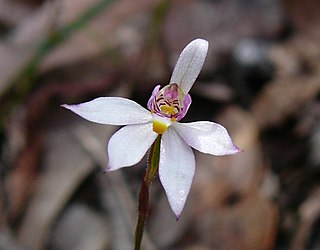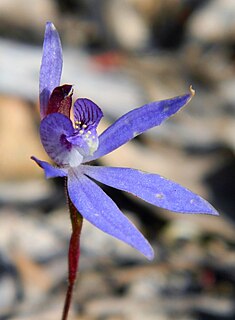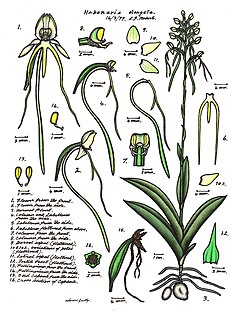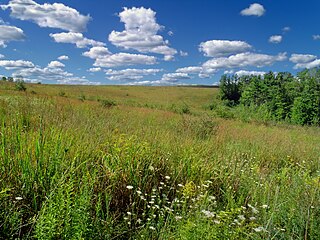
Caladenia flava, commonly known as cowslip orchid, is a species of orchid endemic to the south-west of Western Australia. It is a relatively common orchid with a single, hairy leaf and up to three yellow flowers which often have red markings. In 2001 three subspecies were named and a fourth is recognised but not as yet formally described.

Caladenia latifolia, commonly known as pink fairies is a species of orchid endemic to Australia and is common and widespread in the southern half of the continent and in Tasmania. It has a single, hairy leaf and up to four pink flowers. It is easily distinguished by its relatively large, green leaf, and pink flowers on an unusually tall spike.

Dendrobium aemulum, commonly known as the ironbark feather orchid or white feather orchid, is an epiphytic orchid in the family Orchidaceae and grows on trees that retain their bark, especially ironbarks. It has reddish or purplish pseudobulbs, two to four leathery leaves and up to seven white, feathery flowers. It grows in open forest in Queensland and New South Wales.

Caladenia gracilis, commonly known as musky caps or musky caladenia, is a plant in the orchid family Orchidaceae and is endemic to eastern and south-eastern Australia, including Tasmania. It is a ground orchid with a single leaf and up to six flowers which are dark-coloured on the back and white on the front, sometimes tinged with pink and with a strong musky or soapy odour. The species is also known as Caladenia moschata in Victoria.

Caladenia alata, commonly known as the fairy orchid, is a plant in the orchid family Orchidaceae and is found in south-eastern Australia and New Zealand. It is a ground orchid with small, usually short-lived flowers, which have relatively stiffly held petals and sepals and reddish-purple bars on the labellum.

Caladenia congesta, commonly known as black-tongue caladenia, is a plant in the orchid family Orchidaceae and is endemic to Australia. It is a ground orchid with a single, sparsely hairy leaf, and up to three bright pink flowers with the central part of the labellum completely covered with black calli. It is a widespread species but not common in any part of its range.

Caladenia filamentosa, commonly known as daddy-long-legs, is a plant in the orchid family Orchidaceae and is endemic to eastern Australia. It is a ground orchid with a single hairy leaf and up to four, usually dark red flowers with long, drooping lateral sepals and petals.

Caladenia flava subsp. flava, commonly known as the cowslip orchid, is a species of orchid endemic to the south-west of Western Australia. It is a relatively common orchid with a single, hairy leaf and up to three golden-yellow flowers which often have red markings.

Caladenia flava subsp. maculata, commonly known as the Kalbarri cowslip orchid, is a species of orchid endemic to the south-west of Western Australia. It has a single, hairy leaf and up to three lemon-yellow flowers with brownish-fawn spots on some parts. It mainly occurs in near-coastal areas north of Geraldton.
Caladenia reptans subsp. impensa, commonly known as the pale pink fairy, is a plant in the orchid family Orchidaceae and is endemic to the south-west of Western Australia. It has a single hairy leaf and up to three pale pink flowers which have a labellum with three distinct lobes. It is similar to subspecies reptans except that its leaf is green on both sides and the flowers are larger and on a taller flowering spike.

Caladenia testacea, commonly known as honey caps, or honey caladenia is a plant in the orchid family Orchidaceae and is endemic to New South Wales. It is a ground orchid with a single, sparsely hairy leaf and up to three white to yellowish-green flowers with brownish tips and a darker back.

Caladenia caerulea, commonly known as the eastern tiny blue china orchid, blue caladenia or blue fairy is a plant in the orchid family Orchidaceae and is endemic to eastern Australia. It has a single narrow leaf and a single blue flower.

Caladenia major, commonly known as the waxlip orchid, parson-in-the-pulpit, or purple cockatoo is a plant in the orchid family Orchidaceae and is endemic to Australia. It is a ground orchid with a single hairy leaf and one or two purple to mauve flowers. It has been known as Glossodia major since its description by the prolific Scottish botanist Robert Brown in 1810, but recent discoveries suggest its inclusion in the genus Caladenia.

Pterostylis cucullata, commonly known as the leafy greenhood, is a plant in the orchid family Orchidaceae and is endemic to south-eastern Australia. It has a rosette of fleshy leaves at its base and a single white, green and reddish-brown flower.

Microtis media subsp. media, commonly known as the common mignonette orchid, is a species of orchid which is endemic to the south–west of Western Australia. It is a common, widespread orchid with a single smooth, tubular leaf and a flowering spike with up to one hundred small green flowers. It differs from Microtis media subsp. densiflora in the shape of its flower spike and the shape of its labellum.
Thelymitra angustifolia, commonly known as the long-leaved sun orchid is a species of orchid that is endemic to eastern Australia. It has a single erect, thin, channelled leaf and up to ten purplish blue flowers with white tufts on top of the anther. The flowers are self-pollinating.
Thelymitra media, commonly called the tall sun orchid, is a species of orchid that is endemic to eastern Australia. It has a single fleshy, channelled leaf and up to thirty blue flowers with darker streaks but without spots. The labellum is narrower than the other petals and sepals.

Thelymitra canaliculata, commonly called the flushed sun orchid or blue sun orchid is a species of orchid in the family Orchidaceae and is endemic to the south-west of Western Australia. It has a single erect, fleshy leaf and up to twenty eight blue flowers with darker veins and sometimes flushed with pink. The lobe on top of the anther is blackish with a yellow crest.

Habenaria elongata, commonly known as the white rein orchid, or Kimberley spider orchid, is a species of orchid that is endemic to northern Australia. It has up to four leaves at its base and up to twenty small white flowers with yellowish tips and thread-like lobes on the labellum.
Habenaria ochroleuca, commonly known as the sickle orchid or sickle habenaria, is a species of orchid that is endemic to northern Australia. It has two or three broad, glabrous leaves and up to twenty five white flowers on a flowering stem with many overlapping bracts. The side lobes of the labellum curve upwards.

























